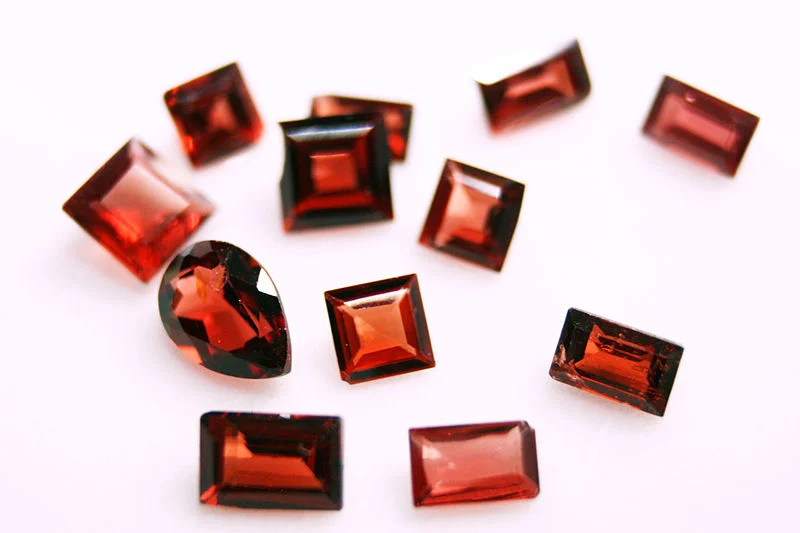Garnet
Garnet covers a wide range of exciting and versatile stones covering everything from low-priced red stones found at markets to high-end gems costing nearly as much as a sapphire. The stones appear in almost every colour imaginable, though it's the blood-red of pyrope which remains the classic. It’s an isomorphous family of minerals, all with the same cubic symmetry and almost identical chemical formulas. The colour are determined by environmental inclusions, resulting in everything from yellow to black. We have a long association with this gemstone, with beads of garnet turning up in prehistoric graves and red cabochons having appeared in jewellery the past five hundred years. Slices of garnet have been used in windows in both churches and temples, and legend has it that Noah suspended garnet in the ark in order to disperse light. A potential reason behind this historic and religious fondness of the stone might be due to the belief that garnet can cure melancholy and warm the heart.
Pyrope
The most characteristic of garnets is the blood-red colour of pyrope, which can easily be confused with either ruby or spinel. The intensity of this hue is due to the stone's high iron and chromium content. The name comes from the Greek pyropos meaning fiery, and the stone was very popular in Bohemian jewellery during the 18th and 19th centuries. It rarely has any inclusions, and high-quality pyrope garnets are mined from the diamond pipes of the Kimberley and De Beers mines in South Africa.
Almandine
Almandine ranges in colour from deep red to violet-red to even black. Cabochons are often hollowed out on the underside to let more light filter through the stone. It is one of the most widespread garnets, occurring in perfectly bounded crystals in large sizes. Although dense, almandine is brittle and faceted edges may chip. Many stones characteristically contain inclusions, some of which appear as a four-rayed star.
Rhodolite
Rhodolite has a beautiful bright violet-red colour with few inclusions. It is a blend of pyrope and almandine garnets, but is viewed as superior to both due to its brighter colour and limited inclusions. The name derives from the Greek rhodos which means pink, and high-quality material is mined in Sri Lanka, Tanzania and Kenya.
Grossular
Grossular garnets occur in a wide selection of colours ranging from colourless to black, but derive their name from the first specimen ever found: a distinctive gooseberry-green stone. This is one of the two varieties of green grossular garnet, also known as massive green garnet and transvaal jade due to its resemblance to raw jade. It is often found with black specs of the mineral magnetite. The second green grossular garnet appears as a transparent crystal with a lime-green hue, also known as tsavorite, and is faceted as a gem and commonly used as a decorative stone. Pure grossular garnets, however, are colourless. It is due to a variety of impurities becoming incorporated during its formations which has caused this range of colours, the pink grossular due to iron, and the orange-brown colour of hessonite due to manganese in addition to iron.
Andradite
Garnets containing titanium and manganese compounds are grouped together as andradite garnets. The most valuable type is demantoid, summoning a vibrant emerald-green colour due to the presence of chromium in the stone. It has a higher dispersion rate than diamonds and can be recognised easily by the characteristic hair-like inclusions. Topazolite, the yellow variety of andradite garnet, varies often from a pale to dark yellow and is only found as small crystals. The final variety of andradite is melanite which often appears as dark red or black in colour.
Colour-changing garnet
These garnets can appear green-blue in daylight (fluorescent light) and magenta-red in incandescent (artificial)light, or alternatively shift between a red-purple and a yellow-red. The stones are a mix of pyrope and spessartite garnets, and are very rare.
Sources:
Judith Crowe, The Jeweller's Directory of Gemstones (London: A&C Black, 2006)
Cally Hall, Gemstones (London: Dorling Kindersley, 1994)
Jaroslaw Bauer and Vladimir Bouska, A Guide in Colour to Precious & Semiprecious Stones (London: Octopus Books, 1983)


